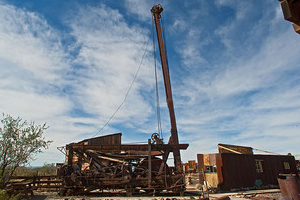Yuma has a rich and unruly history, and there’s plenty of evidence of the rugged sense of adventure and romance of the Wild West, both in the city itself and in the surrounding desert. Officially formed in 1858, Yuma came into existence at the height of the Gold Rush, when a fort was built at the site. There was a rope ferry across the river, and more than 50,000 people made the crossing during the Gold Rush, following the Southern Route, the only wagon trail that went into California.
Eventually a series of bridges were built, replacing the ferries, and ultimately the Southern Pacific Railroad put a bridge across the river in 1877. This is when Yuma really started to thrive. Yuma became a place where could get off the train and take an ice-cold bath for a quarter, much welcomed I’m sure in July, when the average temperature is 42°c and the highest recorded at that time of year is a brain-boiling 51°c, or if you had 75 cents you could get a haircut and shave before continuing on to make your fortune in California.
The Gold Rush turned sour for a lot of folks, who arrived in California to find poverty and disaster.
Many of them travelled back through Yuma, and stayed there to work instead as gold, silver and copper deposits were found. Some of those people found work at the Castle Dome Mine, which was began operating in 1864 and didn’t stop until 1978.
Stephanie and Allen Armstrong bought the property that encompasses the Castle Dome Mine, and what used to be Castle Dome City in 1993. “We were retired and looking for something to do. We saw the property for sale and liked the idea of starting our own museum,” says Allen (Stephanie is an anthropologist, so it made sense).
Castle Dome City used to be a huge community with a church, a bar and everything else you could need back then. You can see this first-hand when strolling around the 40 or so buildings that have been lovingly restored (or built anew in the spirit of how they would have been by the Armstrongs) to create a ghost town, which house the thousands upon thousands of artifacts that the couple keep finding in the mine shafts.
The most valuable things that Allen found, so far, is a pair of 1890 Levis, which he says are the oldest pair in the world and are worth between $25,000 and $45,000 (not that he is interested in selling them, despite a significant amount of interest from collectors in Asia). There are so many weird and wonderful artifacts that the Armstrongs have unearthed, and the way that they have curated their museum means that you can get a real sense of how it would have been to visit the chapel, the general store, or even the brothel, back in the late 1800s.
At Pivot Point Interpretive Plaza, one of the original Southern Pacific locomotives has been placed on the site where it would have stopped in Yuma over a century ago. There is an installation piece, the Ghost Train Sound and Laser system that plays on the hour after dark and lets you imagine how it might have been stepping off that train, way back when. The installation is a little spooky, but interesting.
The famous Yuma Territorial Prison is now a State Historic Park, and is well worth a visit. It opened in 1876, and was only actually operational for 33 years before it closed in 1909 due to overcrowding, but the stories that have come from there or been inspired by the place have turned it into a mythical place full of legends.
There’s a list of the crimes committed by prisoners, posted just in front of the lever used to lock down the cells. The prison housed everyone from murderers to prostitutes to petty thieves, and Yuma attracted all sorts back then. “Everyone had to have a reason for coming to this God awful forsaken frontier. If you were a one-legged drug addicted doctor you could find a home here,” said Tina Clark, the city historian who was showing me around.
There’s a museum section on-site, where you can find out about the colorful characters interned there, such as armed bank robber Pearl Hart, who was the sweetheart of Yuma Prison, and was a celebrity of the time and took her story to vaudeville once released. There is also a collection of vintage movie posters highlighting the many movies in which the prison is featured, including both the old and new versions of The 3:10 to Yuma (and various other westerns).
You can also see a surprising collection of arts and crafts from the inmates, male and female, including some of the most intricate lace I’ve ever seen, knitted by C. E. Hobart, a murderer who spent the majority of his time at Yuma in solitary confinement. “They were allowed to do crafts on Sundays,” explained Clark, “which included being able to make knives. The prison held craft shows and even a Christmas fair where the inmates could sell what they made.”
The whitewashed prison itself is so bright and stark. Walking around the site is eerie: for inmates the heat must have been relentless and the inside of the cells, especially the isolation ones, must have felt like boarding rooms in hell.
The prison is fascinating, as is Yuma in general. This old wild west frontier town has plenty of new stuff to explore too (surprisingly, it is a huge agro-tourism destination), as well as great bars and restaurants. If you get the opportunity to explore this unique part of Arizona, you really should.



